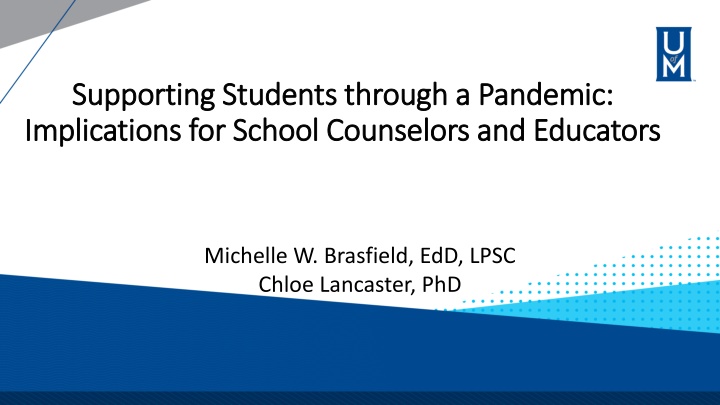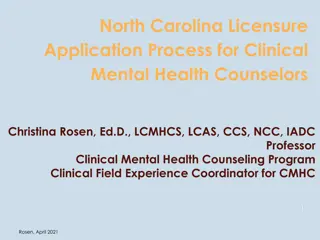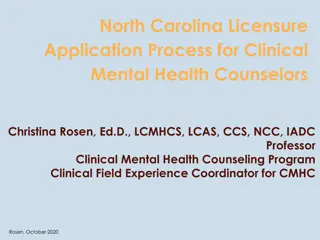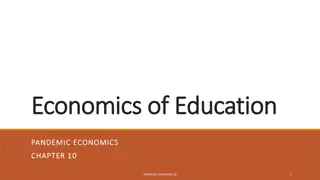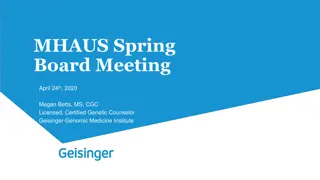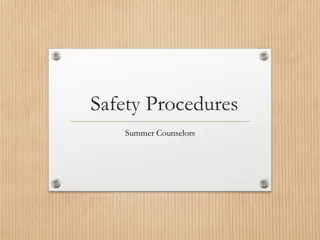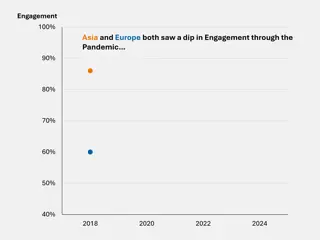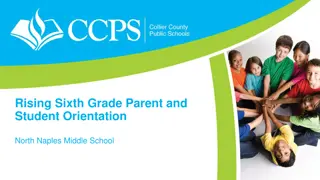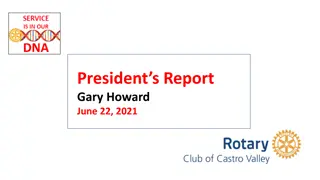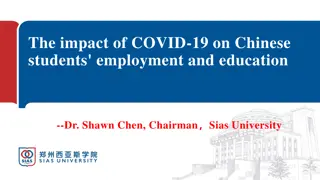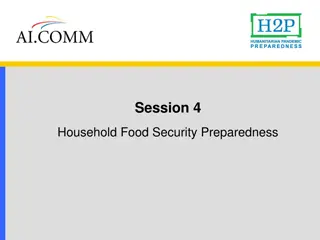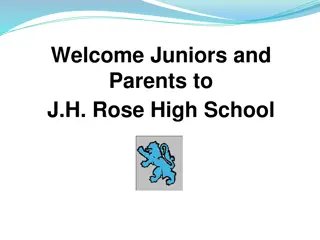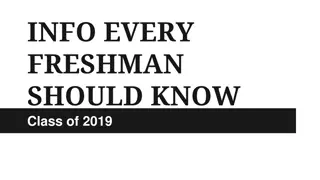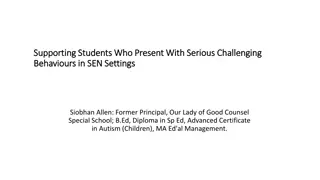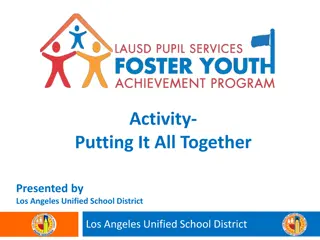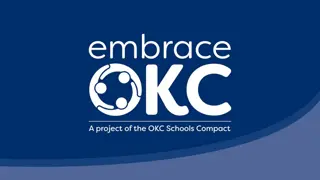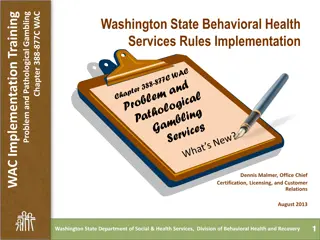Supporting Students Through a Pandemic: Implications for School Counselors
Psychological impacts of the COVID-19 pandemic on students, the role of school counselors, challenges faced post-pandemic, interventions provided by counselors, and necessary support for students and counseling programs to address mental health, academic, and social issues.
Download Presentation

Please find below an Image/Link to download the presentation.
The content on the website is provided AS IS for your information and personal use only. It may not be sold, licensed, or shared on other websites without obtaining consent from the author.If you encounter any issues during the download, it is possible that the publisher has removed the file from their server.
You are allowed to download the files provided on this website for personal or commercial use, subject to the condition that they are used lawfully. All files are the property of their respective owners.
The content on the website is provided AS IS for your information and personal use only. It may not be sold, licensed, or shared on other websites without obtaining consent from the author.
E N D
Presentation Transcript
Supporting Students through a Pandemic: Supporting Students through a Pandemic: Implications for School Counselors and Educators Implications for School Counselors and Educators Michelle W. Brasfield, EdD, LPSC Chloe Lancaster, PhD
Agenda Review Results of a recent study on Tennessee school counselors regarding students mental health, academics, and social skills post COVID-19. Interventions that school counselors provided to their students after the pandemic Barriers to providing services that school counselors experienced post- pandemic Discuss the supports that are needed to assist students and school counseling programs
Introduction Psychological cost of the COVID-19 pandemic has been profound and wide- reaching. Economic instability, grief, fear of infection, social isolation, and uncertain futures have affected the mental health of people world-wide (Brooks et al., 2020). Research has emerged to indicate COVID-19 has further elevated children s mental health problems (Ellis et al., 2020; Karaman et al., 2021; Magson et al., 2021). For students experiencing COVID-19 related trauma and crisis, symptomology has persisted beyond school reentry (Green, 2021). School counselors are often the first responders to students in crisis (Karaman et al., 2021; Lambie et al., 2019), yet researchers have not explored re-entry problems from the school counselors perspective.
Students and COVID-19 Related Distress Research findings indicate that COVID-19 restrictions adversely affected youth in multiple ways including the development of unhealthy eating habits, increased screen time, reduced physical activity, sleep disturbances, academic delays, social problems, and an overall escalation in their mental health concerns (Ellis et al., 2020; Karaman et al., 2021; Magson et al., 2021). Research focused on adolescents has found extended time in social isolation disrupted their developmental reliance on peer interactions for social and emotional support (Imran et al.,2020). Multiple studies have found that not feeling connected to friends, high social media usage, and general COVID-19 related fears were associated with higher levels of depression and anxiety (Ellis et al., 2020; Karaman et al., 2021; Magson et al., 2021). Researchers have found that high school students displayed trauma symptomology during quarantine restrictions with psychological effects related to feeling unsafe, fear of death, and uncertainty about the future (Karaman et al., 2021). While less is known about the impact of COVID-19 on children, evidence is emerging to indicate that the pandemic has elevated Adverse Childhood Experiences (ACEs) (Bryant et al., 2020).
Students Mental Health Even in pre-COVID times, with the rise in school shootings and youth suicide, the mental health of K-12 populations had become a public health concern. According to the National Alliance on Mental Illness (NAMI) one in six children U.S. youth aged 6-17 experienced a mental health disorder (Whitney & Peterson, 2019). Evidence suggests that unaddressed mental health needs contribute to delinquency, substance abuse, poor academic attainment, high risk behaviors, and depressed graduation rates (Mojabai et al., 2015; Peabody et al., 2018; Sanchez et al., 2018). Since re-entry, indicators suggest the pandemic has worsened children s mental health (Karaman et al 2021), with widespread reports of student learning gaps, chronic absenteeism, declines in social skills, and increased behavior problems (Green, 2021). Further, previous research of children s responses to a variety of traumatic events, has found that children and adolescents can develop long-term mental illness following a traumatic experience, which is unlikely to abate without intervention (Udwin et al., 2000).
School Counselors Role in Provision of Mental Health Services Schools have long been discussed as the entry point for mental health services given that children spend much of their day in school, and children and adolescents in need of mental health care are more likely to receive assistance in a school as opposed to a clinical setting (Carlson & Kees, 2013; Lambie et al., 2019). School counselors are the most prevalent mental health professional in schools, with 80.7% of schools employing a full or part time school counselor. By contrast only 66.5% employ a school psychologist and 41.5% employ school social worker (National Center for Educational Statistics, 2016b). School counselors are trained in crisis prevention and responsive services and collaborate with an array of school support personnel to address students academic, developmental, and psychological problems within a multi-tiered framework (Pincus et al., 2020).
School Counselors Role in Provision of Mental Health Services Evidence to support school counselors work in times of crisis comes from multiple sources. Salloum and Overstreet (2008), found that a school counselor-led small group, implemented after Hurricane Katrina, improved PTSD symptoms among elementary school students. Similarly, Udwin (2000) found that students who received psychological support at school, following a national crisis, manifested a reduction in PTSD symptomology. Additionally, scholars have proposed that school counselors utilize their skillset in assessment to administer universal mental health screenings, to identify students who are at greater risk for having or developing mental health concerns (Lambie et al., 2019; Pincus et al., 2020).
Barriers School Counselors Face in the Provision of Services ASCA recommends that school counselor to student ratios not exceed 1:250 (ASCA, 2019), yet the average ratio in the US is 1:455, with some states experiencing ratios above 1:1000 (National Association of College Admission Counselors, 2019). Research has provided evidence to indicate that large school counselor caseloads adversely affect student outcomes, insofar as attendance, graduation, and disciplinary problems are more prevalent in schools with high school counselor caseloads (Parzych et al., 2019). Unfortunately, students of historical minorities in under-resourced schools are disproportionally impacted by high counselor ratios (Whitney & Peterson, 2019) and are more likely to experience adverse educational outcomes, as well as unmet mental health needs (Kaffenberger & O Rorke-Trigiani, 2013).
Barriers School Counselors Face in the Provision of Services ASCA recommends that school counselors spend 80% of their time providing direct and indirect services to students. Direct services include curriculum delivery (e.g., classroom guidance activities), individual student planning (e.g., academic & career advising), and responsive services (e.g., brief individual and small group counseling). Indirect services consist of referrals to other agencies and programs within and outside the school system, and consultation and collaboration with stakeholders, particularly crisis response (ASCA, 2019). Researchers have documented the favorable effects upon student academics and behaviors when school counselors follow these national guidelines for time and role allocations (Cholewa et al., 2015; Davis et al., 2013). Nonetheless school counselors are often assigned non-counseling duties by their campus and district administrators (Gysbers & Henderson, 2012) that prevent school counselors from fulfilling their appropriate roles. These duties notably include, test coordination, record keeping, attendance monitoring, substitute teaching, and student discipline (ASCA, 2019). Data indicate non-counseling duties may be more problematic at the secondary level with high school counselors reporting significantly more non-counseling duties, particularly in comparison to elementary school counselors (Chandler et al., 2018; Gysbers & Henderson, 2012). Geographic differences have also been documented, with rural schools being significantly higher in non- counseling duties than urban schools (Chandler et al., 2018).
Purpose of the Study This study was conducted to understand, from a school counselors perspective, the on-going impact of COVID-19 upon students mental health, examine strategies they have deployed to assist students, and barriers encountered to providing care to meet their students level of need. Because we support the contention that mental health manifests in a plethora of academic, behavior, and social skill adjustment issues, for children and adolescents, we also examined school counselors' perceptions of changes in these domains from pre-pandemic to current times. Given documented patterns of variability in school counselor programs, we also investigated school counselors perceived ability to assist students by location, SES, and assigned non-counseling duties.
Survey Extension of previous study prior to COVID-19 (Brasfield, et al., 2021; Lancaster et al., 2021), upon request by Senator Heidi Campbell 207 public school counselors in TN with in-person programs for fall 2021 completed a survey for the following research questions: How has COVID-19 affected students mental health, academics, and social skills? What issues seem to present the greatest concerns? Also, does this differ based on grade level (elementary, middle, or high school), location (urban, suburban, or rural), and socioeconomic status (Title I or non-Title I). What interventions have school counselors used in assisting students with their COVID-19 related concerns and does this differ by grade level (elementary, middle, or high school), location (urban, suburban, or rural), and socioeconomic status (Title I or non-Title I? What barriers do school counselors report as influencing their ability to provide services, and are the barriers to providing services affected by grade level (elementary, middle, or high), location (urban, suburban, or rural) socioeconomic status (Title I or non-Title I), number of additional non- counseling duties, size of caseload (small, medium, or large), and following the state mandate for providing 80% direct and indirect services ?
Sample Characteristics Characteristic n % Age 18-24 years 3 1.4 25-44 years 99 47.8 45-64 years 102 49.3 65 years plus 3 1.4 Race/Ethnicity Black/African American 17 8.2 Latinx/Hispanic 2 1.0 White/Caucasian 184 88.9 American Indian/Alaskan Native 1 .5 Other 4 1.9 Gender Female 192 92.8 Male 15 7.2
School/Program Characteristics Characteristic n % Location Urban 31 15.0 Suburban 95 45.9 Rural 72 34.8 Unsure 9 4.3 Title I status Yes 121 58.5 No 57 27.5 Unsure 9 4.3 Grade Level Elementary 81 39.1 Middle 42 20.3 High 60 29.0 Other 24 11.6 Follows 80% service mandate Yes 112 54.1 No 65 31.4 Unsure 30 14.5 School counselor to student ratio (caseload) 1:1-300 29 14.0 1:301-550 144 69.6 1:551 and higher 31 15.0 Other 3 1.4
Mental Health Changes Post-Pandemic 93.7% (n = 194) of school counselors reported negative changes in students 42.5% (n= 88) reporting much worse 51.2% (n= 106) reporting somewhat worse Anxiety (92.8%, n = 192) Depression (77.3%, n = 160) Family dysfunction (71.0%, n = 147) COVID-19 related grief and loss (63.8%, n = 132) Technology addiction (52.7%, n = 109) Suicidality (50.7%, n = 105) Fear of COVID-19 (49.8%, n = 103) Substance use issues (21.7%, n = 45) Other (12.6%, n = 26) such as separation anxiety, self-harm, and anger
Mental Health Changes Post-Pandemic Significant relationships with grade level (N = 183) For depression, 90.0% (n = 54) of high school counselors and 85.7% (n = 36) middle school counselors reported this issue as compared to 63.0% (n = 51) of elementary school counselors. For suicidality, 76.2% (n = 32) of middle school counselors and 71.7% (n = 43) of high school counselors reported this concern as compared to 23.5% (n = 19) of elementary school counselors. For substance use, 58.3% (n = 35) of high school counselors and 20.0% (n = 8) of middle school counselors reported this concern as compared to 1.2% (n = 1) of elementary school counselors. All other mental health concerns were not significant with grade level. There was not a significant relationship between school location (N = 198) or Title I status (N = 178) with any of the mental health concerns.
Academic Changes Post-Pandemic 90.3% (n= 187) of school counselors reported negative changes to students academics 35.3% (n= 73) reporting much worse 55.1% (n= 114) reporting somewhat worse Overall decline across all subjects (80.7%, n = 167) Lack of motivation (84.1%, n = 174) Lack of parental support during the school day (75.4%, n = 156) Attention issues (71.0%, n = 147) Poor mental health (64.7%, n = 134) Sleep deprivation (41.1%, n = 85) Limited technology during virtual learning (33.3%, n = 69) Lack of space to work at home during virtual learning (30.4%, n = 63) Poor physical health (17.9%, n = 37) Other (3.9%, n = 8)
Academic Changes Post-Pandemic Significant relationship with grade level (N = 183) For lack of motivation, 96.7% (n = 58) of high school counselors and 88.1% (n = 37) of middle school counselors reported this issue as compared to 75.3% (n = 61) of elementary school counselors. For poor mental health, 78.3% (n = 47) of high school counselors and 69.0% (n = 29) of middle school counselors reported this outcome as compared with 49.4% (n = 40) of elementary school counselors. For attention issues, 79.0% (n = 64) of elementary school counselors and 73.8% (n = 31) of middle school counselors reported concerns as compared to 55.0% (n =33) of high school counselors.
Academic Changes Post-Pandemic Significant relationship with location (N = 198) For attention issues with 87.1% (n = 27) of school counselors in urban schools, 73.7% (n = 70) in suburban schools, and 59.7% (n = 43) in rural schools indicating concerns. Significant relationship with Title I status (N = 178) For attention issues with 76.9% (n = 93) of school counselors at Title I schools indicating concerns as compared to 56.1% (n = 32) of those in non-Title I schools. All other non-cognitive factors were not significant with grade level, location, and Title I status. Of note, there was a significant relationship between Title I status and location (N = 172) with 88.5% (n = 23) of urban schools and 79.4% (n = 54) of rural schools having Title I status as compared to 50% (n = 39) of suburban schools.
Social Skills Changes Post-Pandemic 87.0% (n= 180) of school counselors reported negative changes to students social skills 36.2% (n= 75) reporting much worse 50.7% (n= 105) reporting moderately worse Issues with trouble socializing with peers (84.1%, n = 174) Increase in cyberbullying (23.7%, n = 49) Absence of social flexibility (58.0 %, n = 120) Increase of physical aggression (55.1%, n = 114) Increase in relational aggression (50.7%, n = 105) Increase in bullying (19.3%, n = 40) Other (8.2%, n = 17) such as issues with conflict resolution, lack of filter, and preference for technology
Social Skill Changes Post-Pandemic Significant relationship for grade level (N = 183) For cyberbullying with 42.9% (n = 18) of middle school counselors, 23.3% (n = 14) of high school counselors, and 14.8% (n = 12) of elementary school counselors reporting an increase in this area. All other social skills changes were not significant with grade level. No social skills changes were significant with school location (N = 198) and Title I status (N = 178).
Supports and Interventions Post-Pandemic Individual counseling (95.7%, n = 198) Consultation with parents/teachers (85.5%, n = 177) Referrals (80.7%, n = 167) Collaboration with other school-based helpers (77.3%, n = 160) Coping skills instruction (71.5%, n = 148) Group counseling (44.0%, n = 91) Universal mental health screenings(17.9% n = 37) Other interventions (4.3%, n = 9) such as food programs, holidays donation programs, peer support, and academic support meetings
Supports and Interventions Post-Pandemic Significant relationship between grade level (N = 183) and supports For small group counseling 63.0% (n = 51) of elementary school counselors and 45.2% (n = 19) of middle school counselors provided this support as compared to 16.7% (n = 10) of high school counselors. For coping skills instruction 77.8% (n = 63) of elementary school counselors and 71.4% (n = 30) of middle school counselors reported this intervention as compared to 56.7% (n = 34) of high school counselors. Significant relationship between location (N = 198) and supports For small group counseling, 72.2% (n = 20) of rural school counselors, 61.3% (n = 19) of urban school counselors, and 51.6% (n = 46) of suburban school counselors providing this intervention. None of the other supports were significant with location or grade level. There was no significant relationship between Title I status (N = 178) and these supports.
School Counselors Barriers Post-Pandemic 54.6% (n = 113) of school counselors reported that they have experienced barriers, and 45.4% (n = 94) reported that they have not High case load (44.4%, n = 92) Large number of non-counseling duties (20.3%, n = 42) Lack of administrator support (12.1%, n = 25) On master schedule for guidance classes (10.1%, n = 21) Lack of training to address COVID-19 needs (8.2%, n = 17) Too much time coordinating the MTSS program (7.7%, n = 16) Other reasons (9.7%, n= 20). Examples of other reasons include students attendance, lack of resources (both space and personnel), and focus on academics over mental health.
School Counselors Barriers Post-Pandemic Significant relationship between barriers and grade level (N = 183) Being on the master schedule with 19.8% (n = 16) of elementary school counselors reporting this task as compared to 2.4 % (n = 1) of middle school counselors and 1.7% (n = 1) of high school counselors. Significant relationship between barriers and location (N = 198) Not feeling adequately trained with 22.6% (n = 7) of urban school counselors reporting this concern as compared to 6.9% (n = 5) of rural school counselors and 5.3% (n = 5) of suburban school counselors. Significant relationship between number of new non-counseling duties post- pandemic and perceived barriers to providing services to students (N = 207) Those reporting barriers to providing services had more added non- counseling duties (n = 113, M = 1.22, SD = 1.49) than those who did not report barriers (n = 94, M = .66, SD = 1.04).
School Counselors Barriers Post-Pandemic Significant relationship between specific barriers by case load (N = 204) School counselors reporting that a high case load makes it difficult to address students needs was significant with moderately positive association with 58.1% (n =18) of those with a large case load and 47.2% (n = 68) of those with a medium case load reporting this issues as compared to 10.4% (n = 3) of those with a small case load. Investigating the 80% mandate (N = 177) with excluding those who were unsure if they provided 80% direct and indirect services revealed that 63.3%, (n = 112) followed the mandate and 36.7% did not (n = 65). Reporting too many non-counseling duties was significant with 41.5% (n = 27) not following the mandate noting this issue as compared to 10.7% (n = 12) of those who followed the mandate. All other barriers were not significant with grade level, socioeconomic status, location, number of non-counseling duties, size of case load, and following the 80% mandate. Socioeconomic status according to Title I status (N = 178) was not significant with any of the barriers.
Supports for School Counseling and Students What supports are needed to provide students with more services, with needs indicated by this study? What is the support/intervention? Who is the intended population? Who will provide the support/intervention? What additional resources are needed to provide the support intervention?
Questions and Comments? Contact information: Michelle Brasfield ~ rmwelch@memphis.edu ~ 901.677.8618 (cell)
References American School Counselor Association. (2019). ASCA national model: A framework for school counseling programs (4th ed.). Author. Brasfield, M. W., Lancaster, C., & Burke, M. F. (2021). Exploring factors that affect school counselors use of time. Journal of School Counseling, 19(30). Retrieved from http:/www.jsc.montana.edu/articles/v19n30.pdf Brooks, S. K., Webster, R. K., Smith, L. E., Woodland, L., Wessely, S., Greenberg, N., et al. (2020). The psychological impact of quarantine and how to reduce it: rapid review of the evidence. Lancet 395, 912 920. doi: 10.1016/S0140-6736(20)30460-8 Bryant, D. J., Oo, M., & Damian, A. J. (2020). The rise of adverse childhood experiences during the COVID-19 pandemic. Psychological Trauma: Theory, Research, Practice, and Policy, 12(S1), S193. Carlson, L. A., & Kees, N. L. (2013). Mental health services in public schools: A preliminary study of school counselor perceptions. Professional School Counseling, 16(4), 2156759X150160401. Chandler, J. W., Burnham, J. J., Riechel, M. E. K., Dahir, C. A., Stone, C. B., Oliver, D. F & Bledsoe, K. G. (2018). Assessing the counseling and non-counseling roles of school counselors. Journal of School Counseling, 16(7). n7. https://files.eric.ed.gov/fulltext/EJ1182095.pdf Cholewa, B., Burkhardt, C., Hull, M. (2015). Are school counselors impacting underrepresented students' thinking about post-secondary education? A nationally representative study. Professional School Counseling, 19(1), 144-154. https://doi.org/10.5330/1096-2409-19.1.144
References Davis, P., Davis, M. P., & Mobley, J. A. (2013). The school counselor s role in addressing the Advanced Placement equity and excellence gap for African American students. Professional School Counseling, 17(1), 32-39. https://doi.org/10.1177/2156759X0001700104 Ellis, W. E., Dumas, T. M., & Forbes, L. M. (2020). Physically isolated but socially connected: Psychological adjustment and stress among adolescents during the initial COVID-19 crisis. Canadian Journal of Behavioural Science/Revue canadienne des sciences du comportement, 52(3), 177. Green, E. L., (2021). The students returned, but the fallout from a long disruption Remained. The New York Times. https://www.nytimes.com/2021/12/24/us/politics/covid-school-reopening-teen-mental-health.html Gysbers, N. C., & Henderson, P. (2012). Developing and managing your school guidance and counseling program (5th ed.).American School Counseling Association. Imran, N., Zeshan, M., & Pervaiz, Z. (2020). Mental health considerations for children & adolescents in COVID-19 Pandemic. Pakistan journal of medical sciences, 36(COVID19-S4), S67. Kaffenberger, C. J., & O Rorke-Trigiani, J. (2013). Addressing student mental health needs by providing direct and indirect services and building alliances in the community. Professional School Counseling, 16, 323- 332. doi: 10.1177/2156759 X1201600505 Karaman, M. A., E ici, H., Tomar, . H., & Aliyev, R. (2021). COVID-19: Are School Counseling Services Ready? Students' Psychological Symptoms, School Counselors' Views, and Solutions. Frontiers in Psychology, 12.
References Lambie, G. W., Stickl Haugen, J., Borland, J. R., & Campbell, L. O. (2019). Who Took" Counseling" out of the Role of Professional School Counselors in the United States?. Journal of School-Based Counseling Policy and Evaluation, 1(3), 51-61. Lancaster, C., Welch-Brasfield, M., & Burke, M. F. (2021). Examining Variation in Compliance to a New School Counselor Policy by School and School Counseling Program Variables. Journal of School-Based Counseling Policy and Evaluation, 3(2), 61-72.https://doi.org/https://doi.org/10.25774/krkq-5577 Magson, N. R., Freeman, J. Y., Rapee, R. M., Richardson, C. E., Oar, E. L., & Fardouly, J. (2021). Risk and protective factors for prospective changes in adolescent mental health during the COVID-19 pandemic. Journal of youth and adolescence, 50(1), 44-57. Mojtabai, R., Stuart, E. A., Hwang, I., Eaton, W. W., Sampson, N., & Kessler, R. C. (2015). Long-term effects of mental disorders on educational attainment in the National Comorbidity Survey ten-year follow-up. Social Psychiatry and Psychiatric Epidemiology, 50, 1577-1591. doi:10.1007/s00127-015-1083-5 National Association for College Admission Counseling. (2011). 2011 state of college admissions. Author. National Center for Education Statistics. (2016b). Number of students, number of full-time equivalent (FTE) counselors, psychologists, and social workers, and number of students per FTE counselor, psychologist, or social worker in public schools with those staff members, by selected school characteristics: 2015-16. In National Teacher and Staff Survey. R https://nces.ed.gov/surveys/ntps/ tables/ntps1516_027_s1n_04a.asp Parzych, J., Donohue, P., Gaesser, A., Chiu, M. (2019). Measuring the impact of school counselor ratios on student outcomes. ASCA Research Report. Retrieved from www.schoolcounselor.org/asca/media/asca/Publications/ Research-Release-Parzych.pdf Peabody, M., Perryman, K. L., Hannah, M., Smith, L., & Sanyshyn, S. M. (2018). Improving mental health outcomes for young children through the implementation of the Primary Project. Journal of School-Based Counseling Policy and Evaluation, 1, 40- 50.
References Pincus, R., Hannor-Walker, T., Wright, L., & Justice, J. (2020). COVID-19 s effect on students: How school counselors rise to the rescue. NASSP Bulletin, 104(4), 241-256. Salloum, A., & Overstreet, S. (2008) Evaluation of individual and group grief and trauma interventions for children post disaster. Journal of Clinical Child & Adolescent Psychology, 37(3), 495-507. https://doi.org/10.1080/15374410802148194 Sanchez, A. L., Cornacchio, D., Poznanski, B., Golik, A., Chou, T., & Comer, J. (2018). The effectiveness of school-based mental health services for elementary- aged children: A meta-analysis. Journal of the American Academy of Child & Adolescent Psychiatry, 57, 153-165. Udwin, O., Boyle, S., Yule, W., Bolton, D., and O Ryan, D. (2000). Risk factors for long-term psychological effects of a disaster experienced in adolescence: predictors of post-traumatic stress disorder. J. Child Psychol. Psychiatry 41, 969 979. doi: 10.1111/1469-7610.00685 Whitney, D. G., & Peterson, M.D. (2019). US national and state-level prevalence of mental health disorders and disparities of mental health care use in children. JAMA Pediatrics, 173(4):389 391. doi:10.1001/jamapediatrics.2018.5399
